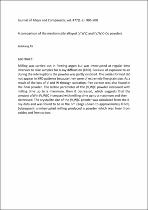JavaScript is disabled for your browser. Some features of this site may not work without it.
- ResearchSpace
- →
- Research Publications/Outputs
- →
- Journal Articles
- →
- View Item
| dc.contributor.author |
Bolokang, AS

|
|
| dc.date.accessioned | 2009-04-24T14:12:58Z | |
| dc.date.available | 2009-04-24T14:12:58Z | |
| dc.date.issued | 2008 | |
| dc.identifier.citation | Bolokang, AS. 2009. Comparison of the mechanically alloyed (V,W)C and (V,W)C-co powders. Journal of alloys and compounds, vol. 477(1-2): 905-908 | en |
| dc.identifier.uri | http://hdl.handle.net/10204/3343 | |
| dc.description | Copyright: 2008 Elsevier. Due to copyright restrictions, the attached PDF file only contains the abstract of the full text item. For access to the full text item, please consult the publisher's website. | en |
| dc.description.abstract | Milling was carried out in flowing argon but was interrupted at regular time intervals to take samples for Xray diffraction (XRD). Because of exposure to air during the interruptions the powder was partly oxidized. The oxides formed did not appear in XRD patterns because they were of extremely fine grain size.As a result of the loss ofVandWthrough oxidation, free carbonwas also found in the final powder. The lattice parameter of the (V,W)C powder increased with milling time up to a maximum, then it decreased, which suggests that the amount ofWin (V,W)C increased with milling time up to a maximum and then decreased. The crystallite size of the (V,W)C powder was calculated fromthe X-ray data and was found to be in the nmrange (down to approximately 8 nm). Subsequent uninterruptedmilling produced a powder which was freer from oxides and free carbon | en |
| dc.language.iso | en | en |
| dc.publisher | Elsevier B.V. | en |
| dc.relation.ispartofseries | Abstract | en |
| dc.subject | Mechanical alloying | en |
| dc.subject | (V,W)C | en |
| dc.subject | V,W)C–Co | en |
| dc.subject | (V,W)C–Co | en |
| dc.subject | Nano-sized | en |
| dc.subject | XRD analysis | en |
| dc.subject | X-ray diffraction | en |
| dc.title | Comparison of the mechanically alloyed (V,W)C and (V,W)C-co powders | en |
| dc.type | Article | en |
| dc.identifier.apacitation | Bolokang, A. (2008). Comparison of the mechanically alloyed (V,W)C and (V,W)C-co powders. http://hdl.handle.net/10204/3343 | en_ZA |
| dc.identifier.chicagocitation | Bolokang, AS "Comparison of the mechanically alloyed (V,W)C and (V,W)C-co powders." (2008) http://hdl.handle.net/10204/3343 | en_ZA |
| dc.identifier.vancouvercitation | Bolokang A. Comparison of the mechanically alloyed (V,W)C and (V,W)C-co powders. 2008; http://hdl.handle.net/10204/3343. | en_ZA |
| dc.identifier.ris | TY - Article AU - Bolokang, AS AB - Milling was carried out in flowing argon but was interrupted at regular time intervals to take samples for Xray diffraction (XRD). Because of exposure to air during the interruptions the powder was partly oxidized. The oxides formed did not appear in XRD patterns because they were of extremely fine grain size.As a result of the loss ofVandWthrough oxidation, free carbonwas also found in the final powder. The lattice parameter of the (V,W)C powder increased with milling time up to a maximum, then it decreased, which suggests that the amount ofWin (V,W)C increased with milling time up to a maximum and then decreased. The crystallite size of the (V,W)C powder was calculated fromthe X-ray data and was found to be in the nmrange (down to approximately 8 nm). Subsequent uninterruptedmilling produced a powder which was freer from oxides and free carbon DA - 2008 DB - ResearchSpace DP - CSIR KW - Mechanical alloying KW - (V,W)C KW - V,W)C–Co KW - (V,W)C–Co KW - Nano-sized KW - XRD analysis KW - X-ray diffraction LK - https://researchspace.csir.co.za PY - 2008 T1 - Comparison of the mechanically alloyed (V,W)C and (V,W)C-co powders TI - Comparison of the mechanically alloyed (V,W)C and (V,W)C-co powders UR - http://hdl.handle.net/10204/3343 ER - | en_ZA |






